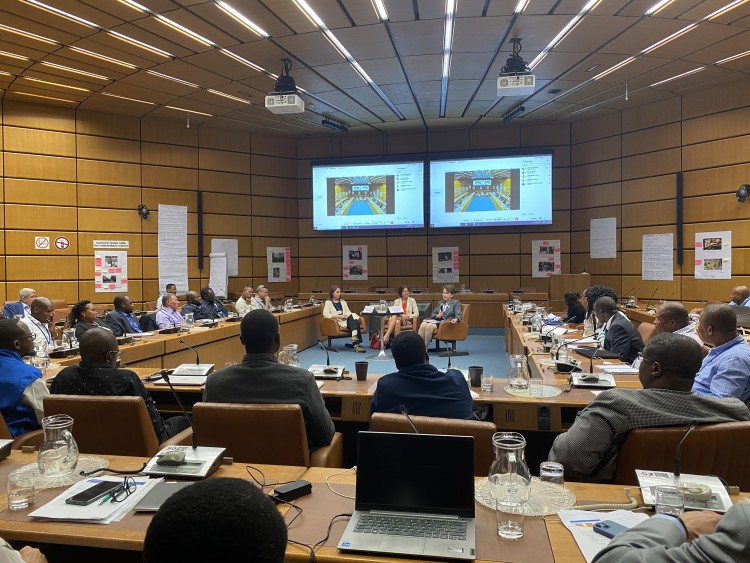Participants at an IAEA School on Nuclear and Radiological Leadership for Safety learned about a range of aspects of nuclear safety during a two week course that concluded today. The topics included: developing leadership for safety at individual and organizational levels; systemic approaches to nuclear safety; internal and external communication strategies relating to safety at nuclear facilities; and the importance of a robust safety culture. This school was the second to be hosted in Nice, France, with the first pilot School, held six years ago, hosted at the Universite Cote d'Azur, (UCA).
"Nuclear professionals who attend the school learn through a variety of methods including presentations, briefings, individual study, in-class group work and discussions. They are guided by leaders in the field to pursue goals, strategies, and plans, with an individual commitment to the protection of people and the environment from harmful effects of ionizing radiation. The school is in high demand from the Member States," said Shahid Mallick, the Director of the IAEA Office of Safety and Security Coordination.
A total of 22 participants from Brazil, Canada, Estonia, India, Indonesia, Kenia, Madagascar, Malawi, Malaysia, Philippines, Portugal, Saudi Arabia, Slovenia, South Africa, Spain, Thailand, Ukraine and Zimbabwe engaged and interacted on various aspects of nuclear safety. They took part in lectures and group work. The School created the opportunity for participants to analyse case studies based on real life scenarios, such as unintentional medical exposure to radiation, a nuclear power plant outage, leaks of radioactive materials into the environment and the effective establishment of a regulatory body.
Among those attending the School were nuclear power plant operators, professionals involved in creating a country's first nuclear power programme, as well as professionals using nuclear technology for medical applications, regulators, safety assessors and psychologists.
"This experience has been incredibly positive. The dedication and effort put forth by the mentors are truly commendable," said Petro Zybin, Head of Safety Analysis Service of the Ukrainian Nuclear Energy Generating Company (Energoatom). "They go above and beyond to ensure that the participants will receive high-quality training and be well-prepared for their roles in this critical field. One aspect that particularly stands out to me is the approach to delivering the programme, encouraging active participation and a collaborative learning environment. This hands-on approach helps me understand and apply the knowledge gained effectively."
The IAEA School of Nuclear and Radiological Leadership for Safety was developed to support the practical implementation of the safety requirements contained in the IAEA Safety Standards Series No. GSR Part 2. These requirements are reflected in the theoretical and practical demonstrations conducted during the School. For example, a selected group of accident scenarios in the nuclear and radiological field were used for group guided discussion on the safety-first principle in the event of any nuclear or radiological incident.
Marcos De Toro Fernandez, an expert on radioactive waste management at the Spanish Nuclear Safety Council (CSN) said: "This School was a great opportunity to learn about leadership and management for safety through the analysis of several cases and scenarios. I will certainly apply and share this knowledge with my colleagues in order to foster safety culture in our organization and at Spanish nuclear power plants."
This experience has been incredibly positive. The dedication and effort put forth by the mentors are truly commendable

Participants during an interactive group activity entitled "safety path." (Photo:M.Haage)
Expressing her appreciaton, Patricia Beringhs Rio Gasparian, a technologist at the Brazilian Nuclear Energy Commission (CNEN) said: "the IAEA School on Nuclear and Radiological Leadership for Safety is unique. In a very dynamic way, it brings important information, effective tools and deep insights on nuclear and radiological leadership for safety. I feel my career has a 'before IAEA Leadership School' and an 'after IAEA Leadership School'."
The IAEA Leadership School programme has also strengthened its links with research and universities through its collaboration with the European Leadership for Safety Education (ELSE). Under a project, an in-depth academic syllabus for safety leadership education has been developed, and it results in a diploma from UCA university. "The first ELSE annual course has concluded with very positive results. We are looking forward to its continuation as a top academic offer in Europe, which proposes grants for trainees from eligible countries," said Jacques Repussard, Chair of the ELSE Project Committee and former contributing expert to the IAEA Leadership School.
Leadership School for African region
Last month, a School for Nuclear and Radiological Leadership for Safety and Security was held in Vienna, attended by 31 participants from 15 African countries. It was jointly organized by the IAEA Forum of Nuclear Regulatory Bodies in Africa (FNRBA), and included African countries that are part of the Regulatory Infrastructure Development Project (RIDP).

Directors of the IAEA Division of Radiation, Transport, and Waste Safety and IAEA Division of Nuclear Security discuss the IAEA's role as a global leader for nuclear and radiation safety and security. (Photo: V. Tafili/IAEA)
A second IAEA School on Nuclear and Radiological Leadership for Safety and Nuclear Security for the French-speaking African countries will be held in Vienna from 14 until 25 August 2023.
"The School is one of the key capacity building services provided by the IAEA to foster leadership qualities among nuclear professionals," said Lydie Evrard, IAEA Deputy Director General and Head of the Department of Nuclear Safety and Security. "It is aimed at junior and mid-career professionals, those who have an opportunity to influence nuclear safety and security now and, in the years, to come."
Since the School was first piloted, 17 Schools have been attended by more than 400 junior and mid-career professionals in the nuclear and radiological field from nearly 85 countries.
The International School of Nuclear and Radiological Leadership for Safety and Security, supports countries in fostering a robust safety and security culture. The School's curriculum, based on the IAEA safety standards and nuclear security guidance contributes to global nuclear and radiological safety and security by strengthening capacity-building efforts.






